 W
WAgedashi dōfu is a Japanese way to serve hot tofu. Silken firm tofu, cut into cubes, is lightly dusted with potato starch or cornstarch and then deep fried until golden brown. It is then served in a hot tentsuyu broth made of dashi, mirin, and shō-yu, with finely chopped negi, grated daikon or katsuobushi sprinkled on top.
 W
WBai ye is a main ingredient of some traditional Chinese dishes, such as bean curd skin roll that is widely known in southern regions of China and some of north regions of China and bean curd knot (Chinese:百页结). Tofu skin is a kind of pressed tofu. In China, pressed tofu comes in myriad shapes, sizes, and texture. Producers make tofu skin by pressing bean curds under much pressure.
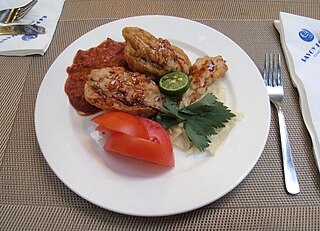 W
WBatagor is a Sundanese dish from Indonesia, and popular in Southeast Asia, consisting of fried fish dumplings, usually served with peanut sauce. It is traditionally made from minced tenggiri (wahoo) fish meat, although other types of seafood such as tuna, mackerel, and prawn may also be used. The fish paste is subsequently stuffed into wonton skins or filled into tofu, and then deep fried in palm oil.
 W
WBún ốc is a Vietnamese dish originating from Hanoi, Vietnam. Roasted or boiled snails, may be eaten first as an appetizer. Snail congee is called cháo ốc, and canh ốc chuối đậu, is a thin snail soup with green banana, fried tofu and tía tô.
 W
WChanpurū (チャンプルー) is an Okinawan stir fry dish. It is considered the representative dish of Okinawan cuisine. Chanpurū generally consists of tofu combined with some kind of vegetable, meat, or fish. Luncheon meat, egg, moyashi and gōyā are some other common ingredients. Spam is not typically used in mainland Japan; but it is more common in Okinawa due primarily to the historical influence of its introduction by the US Navy. Chanpurū is Okinawan for "something mixed" and the word is sometimes used to refer to the culture of Okinawa, as it can be seen as a mixture of traditional Okinawan, Chinese, mainland Japanese, Southeast Asian and North American culture. The term originates from the Malay or Indonesian word campur, meaning "mix".
 W
WDazhu gansi is a specialty dish of Huaiyang cuisine. Dried tofu is sliced into matchsticks and served in chicken stock. Many other ingredients can be added to the tofu. As tofu does not have much flavor, the chef is challenged to produce knifework of great precision and a broth of the highest quality. It is said to have been created in Yangzhou for the Qianlong emperor.
 W
WDouhua is a Chinese sweet or savoury snack made with very tender tofu. It is also referred to as doufuhua, tofu pudding, soybean pudding or, particularly in northern China, tofu brains.
 W
WDubu-kimchi (두부김치) is a Korean dish consisting of tofu and stir-fried kimchi. Soft, warm, blanched tofu is served with well-fermented, tangy baechu-kimchi stir-fried with pork, makes a well-matched anju for either soju or makgeolli.
 W
WGanmodoki is a fried tofu fritter made with vegetables, such as carrots, lotus roots and burdock. It may also contain egg. Ganmodoki means pseudo-goose. This is because ganmodoki is said to taste like goose; compare mock turtle soup. Ganmodoki is also called ganmo for short.
 W
WHiyayakko is a Japanese dish made with chilled tofu and toppings.
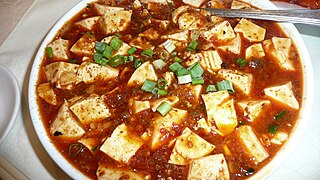 W
WThis is a list of tofu dishes. Tofu, also called bean curd, is a food made by coagulating soy milk and then pressing the resulting curds into soft white blocks. It is a component in many East Asian and Southeast Asian cuisines.
 W
WMapo tofu is a popular Chinese dish from Sichuan province. It consists of tofu set in a spicy sauce, typically a thin, oily, and bright red suspension, based on douban and douchi, along with minced meat, traditionally beef. Variations exist with other ingredients such as water chestnuts, onions, other vegetables, or wood ear fungus. One account indicates that the dish existed as early as 1254, in a suburb of Chengdu, the capital city of Sichuan province.
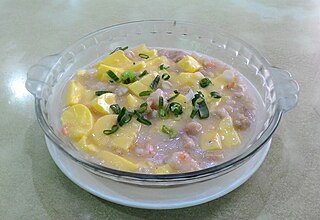 W
WMun tahu is Chinese Indonesian dish of soft tofu braised in savoury thick white sauce, mixed with minced chicken and shrimp.
 W
WPerkedel are vegetable fritters from Indonesian cuisine. Most common perkedel are made from mashed potatoes, yet there are other popular variants which includes perkedel jagung and perkedel tahu and perkedel ikan. Throughout most of Indonesia it is called perkedel; however, it is called begedil in Javanese, and also called that way in Malaysia and Singapore, which could suggest that this fried food was introduced by Javanese immigrants to Malaysia and Singapore.
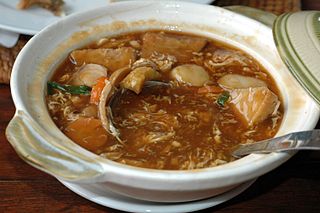 W
WSapo tahu is a Chinese Indonesian tofu dish traditionally cooked and served in claypot. Sapo tahu may be served as a vegetarian dish, or with chicken, seafood, minced beef or pork. It is a popular tofu dish in Indonesia, with several Chinese restaurants competing to serve the best-tasting sapo tahu in Jakarta.
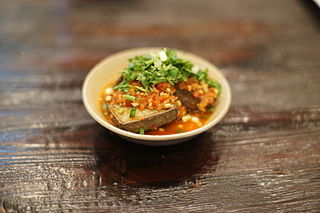 W
WStinky tofu is a Chinese form of fermented tofu that has a strong odor. It is usually sold at night markets or roadside stands as a snack, or in lunch bars as a side dish, rather than in restaurants.
 W
WSundubu-jjigae or soft tofu stew is a jjigae in Korean cuisine. The dish is made with freshly curdled soft tofu, vegetables, sometimes mushrooms, onion, optional seafood, optional meat, and gochujang or gochu garu. The dish is assembled and cooked directly in the serving vessel, which is traditionally made of thick, robust porcelain, but can also be ground out of solid stone. A raw egg can be put in the jjigae just before serving, and the dish is delivered while bubbling vigorously. It is typically eaten with a bowl of cooked white rice and several banchan.
 W
WTahô is a Philippine snack food made of fresh soft/silken tofu, arnibal, and sago pearl. This staple comfort food is a signature sweet and tahô peddlers can be found all over the country.
 W
WTahu campur, literally meaning "mixed tofu" in Javanese language and broader Indonesian language, is an East Javanese tofu dish. The dish consists of sliced tahu goreng, lontong, lentho or sometimes replaced by perkedel, fresh bean sprouts, fresh lettuce, yellow noodles, and krupuk crackers, served in savoury beef stew, garnished with fried onions, and sambal chili sauce. The beef stew soup is seasoned with spices and petis, a type of shrimp paste commonly used in East Javanese cuisine.
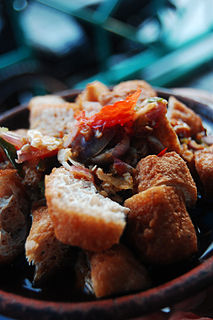 W
WTahu Gejrot is an Indonesian fried tofu in sweet spicy sauce from Cirebon, a port town in West Java, Indonesia. Tahu gejrot consists of tahu pong, a type of hollow tahu goreng cut into small pieces. It is served with a thin and watery dressing that is made by blending palm sugar, vinegar and sweet soy sauce. It is usually served in a small earthenware bowl or layah, with ground garlic, pounded shallot and hot bird's eye chili cut into pieces to add spiciness. Tahu gejrot is usually served in a clay plate.
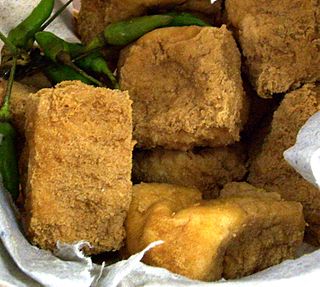 W
WTahu sumedang or Tahu bunkeng is a Sundanese deep-fried tofu from Sumedang, West Java, Indonesia. It was first made by a Chinese Indonesian named Ong Kino. It has some different characteristic from other tofu.
 W
WTahu goreng or Tauhu goreng is a generic name for any type of fried tofu dish in the cuisines of Indonesia, Malaysia and Singapore.
 W
WTofu skin roll or Tofu roll is a dim sum dish. It can be found in Hong Kong and among overseas Chinese restaurants. It is usually served in a small plate in twos or threes. In all cases, the outer layer is made of tofu skin.
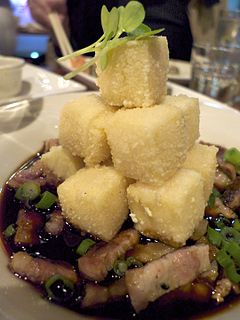 W
WTokwa't baboy is a typical Philippine appetizer. It consists of pork ears, pork belly and deep-fried tofu, and is served in a mixture of soy sauce, pork broth, vinegar, chopped white onions, scallions and red chili peppers. It is usually served as pulutan, as a meal served with rice or as a side dish to rice porridge. Tokwa is the Lan-nang word for firm beancurd, while baboy is the Tagalog word for pork; 't is the contracted form of at, which means "and".
 W
WYeonpo-tang or yeonpo-guk (연폿국) is a Korean soup made with beef, radish, tofu, and kelp stock. It is traditionally made and offered on the day of funeral procession.
 W
WYong tau foo is a Hakka Chinese cuisine consisting primarily of tofu filled with ground meat mixture or fish paste. Variation of this food include vegetables and mushrooms stuffed with ground meat or surimi. Yong tau foo is eaten in numerous ways, either dry with a sauce or served as a soup dish.